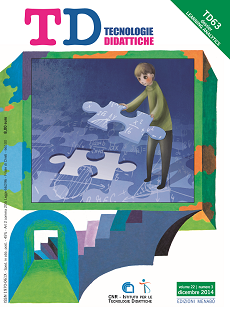Learning Analytics: opportunità per la scuola
Contenuto principale dell'articolo
Abstract
Dettagli dell'articolo
Gli autori che pubblicano su questa rivista accettano le seguenti condizioni:
- Gli autori mantengono i diritti sulla loro opera e cedono alla rivista il diritto di prima pubblicazione dell'opera, contemporaneamente licenziata sotto una Licenza Creative Commons CC BY 4.0 Attribution 4.0 International License.
- Gli autori possono aderire ad altri accordi di licenza non esclusiva per la distribuzione della versione dell'opera pubblicata (es. depositarla in un archivio istituzionale o pubblicarla in una monografia), a patto di indicare che la prima pubblicazione è avvenuta su questa rivista.
- Gli autori possono diffondere la loro opera online (es. in repository istituzionali o nel loro sito web) prima e durante il processo di submission, poiché può portare a scambi produttivi e aumentare le citazioni dell'opera pubblicata (Vedi The effect of Open Access).
Riferimenti bibliografici
Arnab, S. (2014, August 25). GALA report on Learning Analytics for Serious Games [Web log post].Retrieved from http://seriousgamessociety. org/index.php/2014-07-11-14-15-51/explore/ 134-media/794-gala-report-on-learninganalytics- for-serious-games
Bakharia, A., & Dawson, S. (2011). SNAPP: A Bird’s-Eye View of Temporal Participant Interaction. Proceedings of the Learning Analytics and Knowledge, Canada, (pp. 168-173). doi: 10.1145/2090116.2090144
Clow, D. (2013). MOOCs and the funnel of participation. In D., Suthers, K., Verbert, E., Duval, & X., Ochoa. Proceedings of the Third International Conference on Learning Analytics and Knowledge, (LAK 2013), 8-12 April 2013, Leuven, BE (pp. 185-189). New York, NY, USA: ACM.
Coffrin, C., Corrin, L., de Barba, P., & Kennedy, G. (2014). Visualizing patterns of student engagement and performance in MOOCs. Proceedings of the Fourth International Conference on Learning Analytics and Knowledge, USA (pp. 83-92). doi: 10.1145/2567574.2567586
Downes, S. (2010). New technology supporting informal learning. Journal of Emerging Technologies in Web Intelligence, 2(1), 27-33.
Duval, E. (2011). Attention please! learning analytics for visualization and recommendation. Proceedings of the 1st International Conference on Learning Analytics and Knowledge, Canada, (pp. 9-17). doi: 10.1145/2090116.2090118
Fulantelli, G., Taibi D., & Arrigo M. (in press). A framework to support educational decision making in mobile learning. Computers in Human Behavior. doi: http://dx.doi.org/10.1016/j.chb.2014.05.045
Johnson, L., Adams Becker, S., Estrada, V., & Freeman, A. (2014). Horizon Report: 2014 Higher Education. Austin, TX, USA: The New Media Consortium. Johnson, L., Adams Becker, S., Estrada, V., & Freeman, A. (2014b). NMC Horizon Report: 2014 K- 12 Edition. Austin, TX, USA: The New Media Consortium.
Johnson, L., Adams Becker, S., Estrada, V., & Martín, S. (2013). Technology Outlook for STEM+ Education 2013 - 2018: An NMC Horizon Project Sector Analysis. Austin, TX, USA: The New Media Consortium.
Johnson, L., Adams Becker, S., & Estrada, V. (2012). Technology Outlook for STEM+ Education 2012 - 2017: An NMC Horizon Project Sector Analysis. Austin, TX, USA: The New Media Consortium.
Kobsa, A. (1990). User Modeling in Dialog Systems: Potentials and Hazards. AI & Society. 4(3), 214-240.
Kobsa, A. (2007). Privacy-Enhanced Personalization. Communications of the ACM, 50(8), 24-33.
Littlejohn, A. (2013). Understanding massive open online courses. Retrieved from: http:// cemca.org.in/ckfinder/userfiles/files/EdTech%2 0Notes%202_Littlejohn_final_1June2013.pdf
Pea, R. (2014). The Learning Analytics Workgroup: A Report on Building the Field of Learning Analytics for Personalized Learning at Scale. Retrieved from: http://lytics.stanford.edu/law-report/
Sefton-Green, J. (2004). Literature review in informal learning with technology outside school. Bristol, UK: Futurelab.
Selwyn, N. (2012). I Social Media nell'educazione formale e informale tra potenzialità e realtà. TD Tecnologie Didattiche, 20(1), 4-10.
Serrano-Laguna, Á., & Fernández-Manjón, B. (2014). Applying learning analytics to simplify serious games deployment in the classroom. In Global Engineering Education Conference (EDUCON), 2014 IEEE (pp. 872-877). IEEE. doi: 10.1109/EDUCON.2014.6826199
Serrano-Laguna Á., Torrente J., Moreno-Ger P., & Fernández-Manjón B. (2014). Application of Learning Analytics in educational videogames. Entertainment Computing. 5(4), 313-322. doi: http://dx.doi.org/10.1016/j.entcom. 2014.02.003
Siemens, G., & Long, P. (2011). Penetrating the fog: Analytics in learning and education. Educause Review, 46(5), 30-32.
Solomon, G., & Schrum, L. (2007). Web 2.0: New tools, new schools. Washington, D.C., USA: ISTE.
Taibi, D. and Dietze, S. (2013), Fostering Analytics on Learning Analytics Research: the LAK Dataset. In: CEUR WS Proceedings Vol. 974, Proceedings of the LAK Data Challenge, held at LAK2013 - 3rd International Conference on Learning Analytics and Knowledge (Leuven, BE, April 2013).

